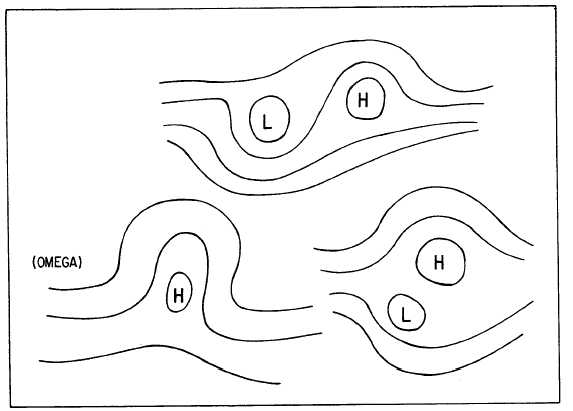|
| |
[ Back ] [ Home ] [ Up ] [ Next ]
Click
here to Order your Radar Equipment Online
Cutoff Highs
Cutoff highs occur when warm tropical air is advected
poleward into the crest of a steep long-wave ridge.
This warm air, and the high that it develops,
ends up on the poleward side of the strongest
westerlies. In this position, it is "cut off"
from receiving additional tropical air.
Cutoff Lows
Cutoff lows take on far more importance than their
counterpart highs because of the bad weather that
accompanies them. In the Northern Hemi-sphere, they
occur most frequently along the southwest
coastal areas of the United States and northwest
coastal areas of north Africa. They form
when cold polar air is advected equatorward into
the base of a deep long-wave trough. This pool
of cold air, and the low it develops, ends
up on the equatorward side of the strongest westerlies.
Figure 8-3-4 shows the typical stages in
the development of a cutoff low. The latter stages
are often associated with occluding low-pressure systems
at the surface; however, cutoff lows
are noted for their production of bad weather without
frontal or cyclonic circulations at the surface.
In the meridional flow of which they are a
part, they are the cold valleys between mountains
of warm air. On the 500-mb chart, the warm
ridge to the west is very sharply oriented southwest
to northeast. To the northeast, an intense
warm stationary high or ridge BLOCKS the
normal path of migratory systems.

Figure
8-3-4.Development of cutoff low.
BLOCKS
Blocking is the
obstructing of the normal west to east progress of migratory systems. Like
cutoffs, blocks are
associated with pronounced meridional flow in the upper levels, occur most
frequently in spring and least often in autumn, and tend to form in the
same geographical regions. In
the Northern Hemisphere, they form most
frequently in the eastern North Atlantic and eastern
North Pacific oceans.
Blocks are warm long-wave ridges or upper- level
highs that take up residence in higher latitudes
and move very slowly, if at all. As a block
sets up and intensifies, it tends to move west (retrograde).
Figure 8-3-5 shows three types of

Figure
8-3-5.Types of blocks.
blocks
that occur in the circulation pattern. Blocking
highs are either warm-core or dynamic systems,
but in either case, they cause a split in the
westerlies. The split causes the migratory systems
to divert from their normal paths. It is at
these times that prolonged periods of good or bad
weather occur.
In the winter of 1976-77, a block developed over
the western United States. Basically, it lasted from
15 Oct 1976 to 20 Feb 1977. To the west of this
block, warm air was transported far north; Alaska
basked in balmy weather. Meanwhile to the
east of the block, the eastern half of the United States
had one of the worst winters on record. Cold
arctic air was advected from over the North Pole
southward to the Bahamas. The Ohio basin was
particularly hard hit and suffered one of its coldest
winters on record. The Chesapeake Bay of
Virginia and Maryland froze over, and ice breakers
were required to keep the shipping lanes open.
The citrus industry of Florida suffered severe
losses, and the list goes on. In the western half
of the United States, drought-like conditions existed,
because the block prevented moisture-laden air
of the Pacific from reaching the coast. Granted,
this block was far from normal, but it serves
to show a blocks effect on weather patterns.
[ Back ] [ Home ] [ Up ] [ Next ]
|
